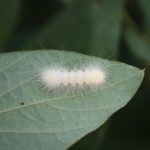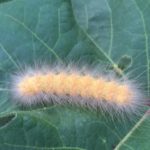It’s the time of year where soybean insects are much more likely to cause us problems, and it is important to vigilantly scout. Although stink bug populations are behind schedule, they are becoming more common. I’ve received numerous questions about a complex of pests including kudzu bug, corn earworm, green cloverworm, loopers, fall armyworm, and saltmarsh caterpillar. I’m not going to attempt to cover all these in detail, but please refer to our soybean insect control recommendations for soybean for suggested treatment thresholds and insecticide options. My take home point is the need for regular scouting. The biggest insect management mistakes are usually the result of not scouting. I will, however, make a couple of specific comments.
I’ve had several people send me pictures of an egg mass or hatching eggs of the saltmarsh caterpillar. This insect appears more common than usual this year. The larvae are defoliators and occasionally build to large numbers (or at least contribute to defoliation caused by a complex of pests). I’ve shared a couple of picture below. The eggs are usually laid in a large mass on the undersides of leaves. Unlike armyworms, the eggs are not covered with moth scales. The large larvae are usually very hairy, but the color and amount of hair may vary significantly. Smaller larvae will also have hairs on the body, but they are often more sparsely distributed.
There is not a specific treatment threshold for saltmarsh caterpillars. I suggest treating on defoliation levels but also consider the number of larvae, including other defoliating species, found in the field. Again, prior to R6, treat if defoliation levels exceed 20-25%. Saltmarsh caterpillars can generally be controlled with pyrethroid insecticides, but Intrepid (4 oz/acre) will likely be more consistent. There are many good alternative products that would also control this pest (e.g., Belt, Blackhawk, Intrepid Edge, Prevathon, and Steward). You might even consider a mix of a pyrethroid plus Intrepid (3-4 oz/acre) or one of the these other products, especially if you are also observing loopers. A mix like this would also be appropriate if kudzu bugs, stink bugs or fall armyworm are also being found. The premixed product Besiege would also be an option.
Please remember that pyrethroid insecticides are not recommended for soybean looper and may actually make infestations worse. Although we sometimes get “decent” control with high rates of acephate (e.g., Orthene), this product does not perform consistently and is not recommended if soybean loopers are the primary target.




